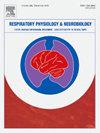七氟醚麻醉小鼠低温期间舌骨上肌活动增强
IF 1.6
4区 医学
Q3 PHYSIOLOGY
引用次数: 0
摘要
卤代挥发性麻醉药不仅能引起严重的呼吸抑制,还能对小型啮齿动物的上气道扩张肌(UAD)产生促进作用。高浓度的七氟醚吸入会引起喘息呼吸,其特征是伴随着下颌运动的呼吸增强,舌骨上肌(SHMs)的活动升高对此有显著贡献。虽然在经七氟醚麻醉的自主呼吸小鼠中也观察到类似的喘气样呼吸,但在低温过程中,七氟醚对SHMs活性的影响尚不清楚。我们研究了七氟醚、戊巴比妥和低温对自主呼吸小鼠通气和SHMs活性的协同作用。将21只经气管插管的小鼠分为七氟醚组(N = 7)、戊巴比妥组(N = 7)和戊巴比妥-七氟醚组(N = 7)。将各组小鼠从37 ~ 36℃降温至25 ~ 24℃,同时通过皮下肌电图(EMGSH)测量体温、呼吸方式和SHMs活性。戊巴比妥组在降温过程中潮气量(VT)和呼吸相关SHMs活性变化最小。相比之下,在七氟醚和戊巴比妥-七氟醚组中,EMGSH的行为类似于UAD肌肉,在低温期间随着VT的增加而增加。值得注意的是,戊巴比妥-七氟醚组在体温34-33℃和31-30℃时EMGSH值明显较大,表明效果更为明显。我们的研究证实了七氟醚在低温下诱导VT增加和SHMs活性增强中的重要作用。此外,在低温期间,在七氟醚麻醉中加入戊巴比妥会导致EMGSH进一步增加,这突出了这些因素的协同作用。本文章由计算机程序翻译,如有差异,请以英文原文为准。
Augmented activity of suprahyoid muscles during hypothermia in sevoflurane-anesthetized mice
Halogenated volatile anesthetics not only cause profound respiratory depression but also exert a facilitatory influence on the upper airway dilator (UAD) muscles in small rodents. A high concentration of sevoflurane inhalation induces gasping respiration characterized by augmented breaths with mandibular movements, to which elevated activity of suprahyoid muscles (SHMs) contributes significantly. Although similar gasping-like breathing has been observed during hypothermia in sevoflurane-anesthetized spontaneously breathing mice, the effect of sevoflurane during hypothermia on SHMs’ activity remains elusive. We investigated the synergistic effects of sevoflurane, pentobarbital, and hypothermia on ventilation and SHMs’ activity in spontaneously breathing mice. The twenty-one tracheally intubated mice were divided into three groups, i.e., the sevoflurane (N = 7), the pentobarbital (N = 7), and the pentobarbital-sevoflurane (N = 7) groups. Progressive hypothermia was produced by cooling mice in each group from 37 to 36℃ to 25–24℃ while measuring body temperature, breathing patterns, and the SHMs’ activity through subcutaneous electromyography (EMGSH). The pentobarbital group showed minimal change in tidal volume (VT) and respiratory-related SHMs’ activity during cooling. In contrast, in the sevoflurane and pentobarbital-sevoflurane groups, the EMGSH, which behaves like the UAD muscle, was augmented with increased VT during hypothermia. Notably, the pentobarbital-sevoflurane group showed significantly larger EMGSH values at body temperatures of 34–33 and 31–30℃, indicating a more pronounced effect. Our study confirms the significant role of sevoflurane in inducing increased VT and augmented SHMs’ activity during hypothermia. Furthermore, adding pentobarbital to sevoflurane anesthesia during hypothermia led to a further increase in augmented EMGSH, highlighting the synergistic effects of these factors.
求助全文
通过发布文献求助,成功后即可免费获取论文全文。
去求助
来源期刊
CiteScore
4.80
自引率
8.70%
发文量
104
审稿时长
54 days
期刊介绍:
Respiratory Physiology & Neurobiology (RESPNB) publishes original articles and invited reviews concerning physiology and pathophysiology of respiration in its broadest sense.
Although a special focus is on topics in neurobiology, high quality papers in respiratory molecular and cellular biology are also welcome, as are high-quality papers in traditional areas, such as:
-Mechanics of breathing-
Gas exchange and acid-base balance-
Respiration at rest and exercise-
Respiration in unusual conditions, like high or low pressure or changes of temperature, low ambient oxygen-
Embryonic and adult respiration-
Comparative respiratory physiology.
Papers on clinical aspects, original methods, as well as theoretical papers are also considered as long as they foster the understanding of respiratory physiology and pathophysiology.

 求助内容:
求助内容: 应助结果提醒方式:
应助结果提醒方式:


